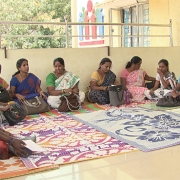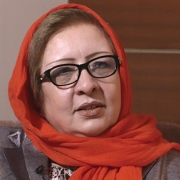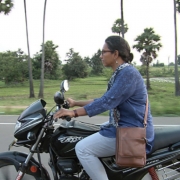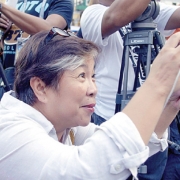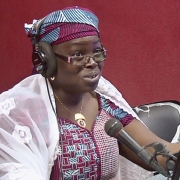
Etcetera
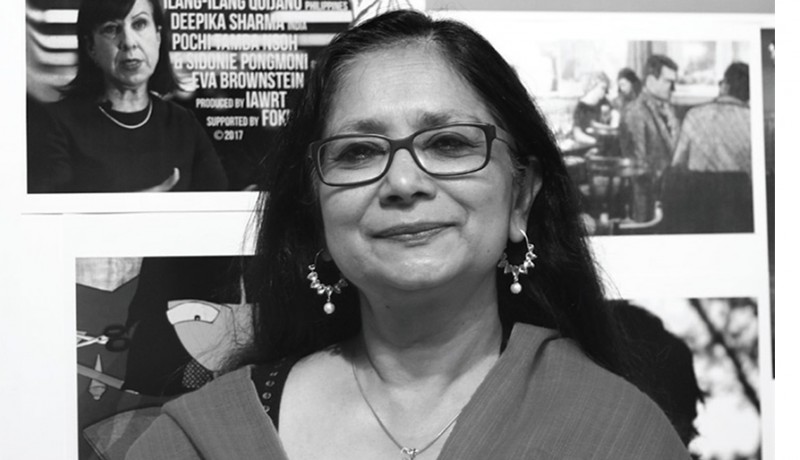
Soft but very strong and having a deep impact—just like the quiet resolve and determination of women journalists around the world’. With that metaphor, Nupur Basu, 59, introduces us to the title of her opus, Velvet Revolution, a documentary on women journalists reporting in conflict areas around the world and the challenges they face while navigating the dangers involved.
“Whether it is rural women in southern India who fought against the Indian Government’s alcohol policy in my first film Dry Days in Dobbagunta (1995), or the amazing women journalists in Velvet Revolution, women across the board are the agents of change” says the award-winning Basu, who has made five documentaries to date, four of them addressing women’s issues.
With Velvet Revolution, the former television journalist has expanded her canvas to work with four other women directors to give a platform to the testimonies of women journalists from seven countries. Produced by the International Association of Women in Radio and Television (IAWRT), the 57-minute, hard-hitting film pans to journalists from war-torn Syria and the dictatorial regime of the Philippines to Boko Haram-infested Cameroon.
From India, it tells the stories of Ritu Sarin of The Indian Express, who led two of her male colleagues in the Indian leg of the Panama Papers investigations; Malini Subramaniam, who reports on human rights violations of tribals in Bastar, Chhattisgarh, and was evicted from her home by a local vigilante group; and, in Andhra Pradesh, E Bharti Yendapalli and her fellow Dalit reporters from Telugu magazine Navoday exposing Dalit discrimination. Basu’s documentary also includes Bangladeshi blogger Rafida Bonya Ahmed, who speaks for the first time on film about life after watching her husband being murdered by Islamic extremists.
Velvet Revolution premiered in Delhi on 3 March before it was screened in New York at the UN Commission on the Status of Women conference. In an email interview with Natasha Rego, Bengaluru-based Basu speaks on the making of the film, its impact and the state of journalism in India. (Velvet Revolution will be screened on 30 May at the UN Conference Hall in New Delhi.)
Did your experience as a journalist influence the film?
As a journalist for over three decades in print, television and the digital media, I guess my insider’s view did play a role in shaping the film. When the IAWRT wanted a documentary produced on ‘Women Making News’, I pitched my vision—I wanted to capture women in print, radio, television and the digital media negotiating their professional duties in a world in conflict.
What were the challenges of bringing it all together?
We first put out a call to IAWRT members who are filmmakers. We received 18 proposals that were vetted by a Long Doc Committee. We picked three proposals from women directors in the Philippines, India and Cameroon.
I was keen to have Rafida Bonya Ahmed on the film for the courage she showed after her husband Abhijit Roy’s brutal killing in Dhaka two years ago. I contacted her in the US, and convinced her to come on board to speak about the fallout of her husband’s killing and how she continued to edit Mukto-Mona, the blog for free thinkers and rationalists that her husband had founded. I personally interviewed the BBC’s Lyse Doucet, Zaina Erhaim from Syria and Najiba Ayubi from Afghanistan. We also reached out to the women journalists in the Panama Papers investigations. The main challenge, then, was editing and getting one comprehensive story out of the different segments, something editors and filmmakers Reena Mohan and Nirmal Chander did extremely skillfully.
This is your first anthology. What were the challenges of this format?
While in my earlier films, I was the director of the standalone documentary film, in this project I came in as executive producer and worked with other directors as well. I guess it was several notches more challenging for that reason. In the earlier model, one was accountable for one’s own work. Here, one was responsible for the work of others as well. But this had the advantage of being a global collaborative model, where for a very small budget, in a very short time, you can get a global story. It also cuts the carbon footprint, which is excellent.
From conception to premiere, how long did it take?
For me, as executive producer and project director, it took about 10 months; for the country directors it took four to five months. There were several interesting things that happened during the making. For instance, right in the middle of filming, Zaina Erhaim’s passport was impounded at Heathrow airport by the British authorities. Zaina, a journalist living in exile in Turkey, was now stuck in the UK with her eight month-old daughter, Zara! In Malini’s case, she got one award while we were making the film and another just after we finished editing it, and we had to incorporate this. As is the nature of documentary filming, real life is organic and the story unfolds in that mode too.
Did working on this film dispel any preconceived notions? Did it reinforce any others?
I think it reinforced the fact that women journalists, like their male counterparts, are increasingly under attack by state and non-state players as they do their jobs. As women, they are exposed to ‘double attacks’—their personal safety is increasingly under threat and the attacks on them through social media are getting nastier and misogynistic.
Where does Indian media stand on a global scale?
There is a disturbing trend of increasing attacks on journalists in India—23 journalists were killed between 2006 and 2015, and there has been no conviction in any of the cases. In a short period of five months in 2015, four journalists were killed—the highest in such a short period in post-Independent India. It is one of the four countries in the Commonwealth, alongside Pakistan and Bangladesh, on which there is now an international radar for attacks on media. India is now one of the 10 deadliest countries to report from. That is a shame! How did we get to this point? The solidarity among journalists needs to be strengthened so attacks on journalists are protested vehemently by the others.
Where do you go from here?
More screenings of Velvet Revolution are being planned in the coming months. As for myself, I will continue to write, speak and mentor on the issues I believe in.
Photos courtesy: Nupur Basu / IAWRT Featured in Harmony — Celebrate Age Magazine May 2017
you may also like to read
-
Cracking the longevity code
Small yet impactful choices can be game-changers, writes Srirekha Pillai At 102, there’s no stopping Chandigarh-based Man Kaur, the world’s….
-
Home, not alone
While a regulatory framework is vital for senior-care facilities, the need of the hour is to develop an ecosystem to….
-
Birthday Girl
Published in a special edition to honour Japanese master storyteller Haruki Murakami’s 70th birthday, Birthday Girl (Penguin; Rs 100; 42….
-
A huge treat for music lovers
Published as the revised and updated second edition, Incomparable Sachin Dev Burman (Blue Pencil; Rs. 599; 470 pages) the authoritative….



